Search the Special Collections and Archives Portal
Search Results
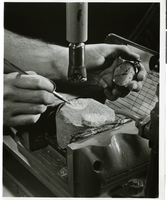
Photograph of a drill bit at the Hughes Tool Co., Houston, Texas, circa 1950s
Date
1950 to 1959
Archival Collection
Description
Transcribed from attached press release: "LITTLE BIT Only an inch and a quarter in diameter, this "microbit" enables engineers at the Hughes Tool Company, Houston, Texas, to estimate the performance of full-size bits for the oil drilling industry. The company operates the largest testing laboratory of its kind anywhere in the world and produces thousands of rock bits necessary to drill deeper and deeper as the world's shallow oil wells have become exhausted. Howard Hughes terms the Hughes Tool company the "keystone" of his industrial empire."
Image
Lee Pete interview, 1999 July 03 to 1999 July 31
Level of Description
File
Archival Collection
Penelope Ruchman Collection of Las Vegas, Nevada Casino Professionals Oral Histories
To request this item in person:
Collection Number: MS-00907
Collection Name: Penelope Ruchman Collection of Las Vegas, Nevada Casino Professionals Oral Histories
Box/Folder: Box 01, Digital File 00
Collection Name: Penelope Ruchman Collection of Las Vegas, Nevada Casino Professionals Oral Histories
Box/Folder: Box 01, Digital File 00
Archival Component
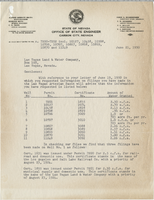
Letter from Hugh A. Shamberger (Carson City) to Las Vegas Land and Water Company (Las Vegas), June 21, 1950
Date
1950-06-21
Archival Collection
Description
List of wells owned by the Las Vegas Land and Water Company and the amount of water granted to each.
Text
Julie's Trip, 2002
Level of Description
File
Archival Collection
Guide to the Canadian Film Centre Worldwide Short Film Festival Submissions
To request this item in person:
Collection Number: MS-00615
Collection Name: Guide to the Canadian Film Centre Worldwide Short Film Festival Submissions
Box/Folder: Box 2003-036
Collection Name: Guide to the Canadian Film Centre Worldwide Short Film Festival Submissions
Box/Folder: Box 2003-036
Archival Component
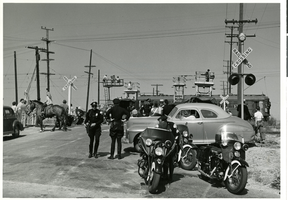
Photograph of a crowd watching the fuselage of Hughes Flying Boat in transit, California, June 16, 1946
Date
1946-06-16
Archival Collection
Description
Transcribed from stamp on back of photo: "June 16, 1946; Hughes Aircraft Photo." Crowds and policeman watching as a section of Howard Hughes' "Spruce Goose" or "Flying Boat" was being moved (with a police escort) from the Hughes Aircraft plant in Culver City, California to Terminal Island in the Los Angeles Harbor where the plane was assembled June 1946. The men are raising the power lines so the fuselage can pass under.
Image
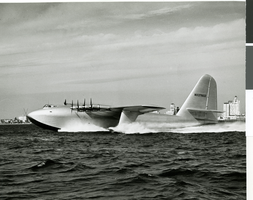
Photograph of the HK-1, Hughes Flying boat, as it returns from its historic test flight, November 2, 1947
Date
1947-11-02
Archival Collection
Description
A side view of the HK-1, Hughes Flying Boat, the world's largest plane, which successfully completed its first flight. The eight 3,000 horsepower engines lifted the craft from the waters of Los Angeles Harbor with Hughes at the controls. The plane is 219 ft long.
Image
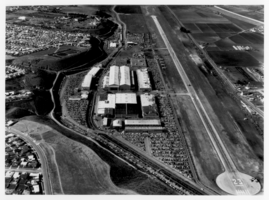
Aerial photograph of Hughes Airport, Culver City, California, circa early 1960s
Date
1960 to 1965
Archival Collection
Description
Aerial view of the airport at Hughes' aircraft plant in Culver City, California. The airport's runway was in operation from 1941 to 1985.
Image
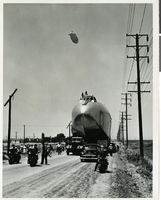
Photograph of the fuselage section of the Hughes Flying Boat being moved to Terminal Island, California, 1946
Date
1946
Archival Collection
Description
A section of Howard Hughes' "Spruce Goose" or "Flying Boat" being moved (with a police escort) from the Hughes Aircraft plant in Culver City, California to Terminal Island in the Los Angeles Harbor where the plane was assembled in June of 1946.
Image
Dunn, Julie, undated
Level of Description
File
Archival Collection
Frank Mitrani Photographs
To request this item in person:
Collection Number: PH-00332
Collection Name: Frank Mitrani Photographs
Box/Folder: Box 54
Collection Name: Frank Mitrani Photographs
Box/Folder: Box 54
Archival Component
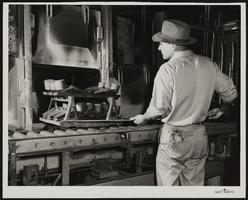
Photograph of a worker at Hughes Tool Company, Houston, Texas, circa 1940s-1950s
Date
1940 to 1959
Archival Collection
Description
Press release attached to back of photo: "A roughneck fits a new Hughes Jet bit into the drill collar preparatory to running the drill stem into the hold. In 1953 more than 500,000 rock bits produced by the Hughes Tool Company of Houston, Texas, were used in the United States alone. The invention of the rock bit by Howard R. Hughes, Sr., made it possible to drill far deeper into the earth beyond the shallow oil deposits which are now practically exhausted. Without rotary drilling equipment of this kind the world might revert to a horse and buggy economy."
Image
Pagination
Refine my results
Content Type
Creator or Contributor
Subject
Archival Collection
Digital Project
Resource Type
Year
Material Type
Place
Language
Records Classification
